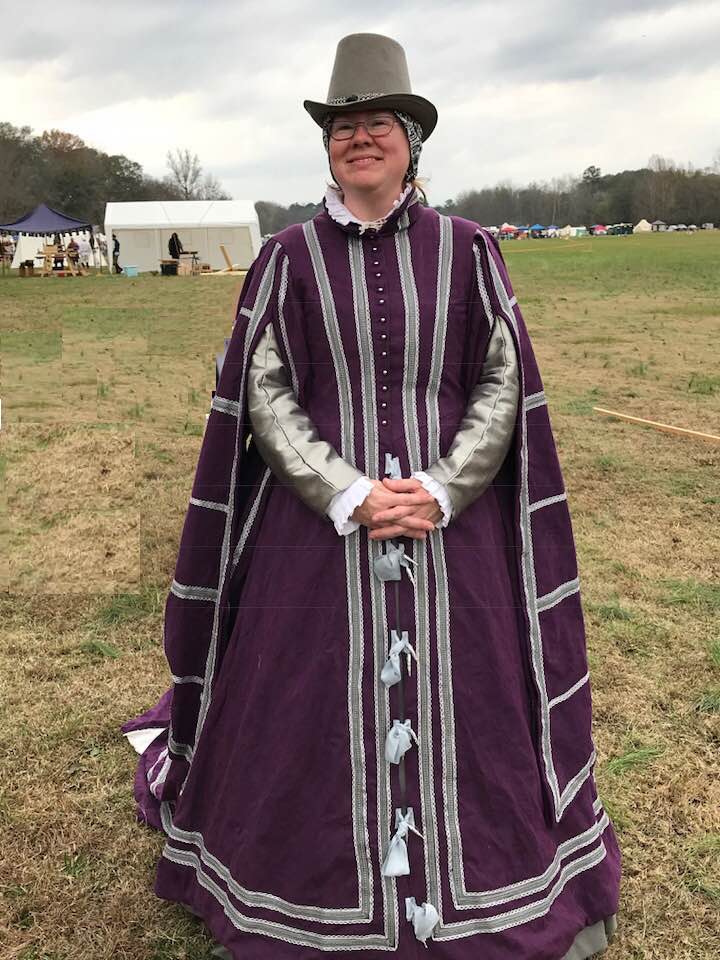 Monghil Trancado, pt 2: Construction, Fit, and Finish
Monghil Trancado, pt 2: Construction, Fit, and Finish
(COVER PHOTO BY TONYA VOTS.)
Construction
Once I created the pattern on the white linen canvas, it was necessary to cut the fashon fabric. Then, I adapted the Modern Maker’s pad stitching layout for doublet backs and fronts to this garment.
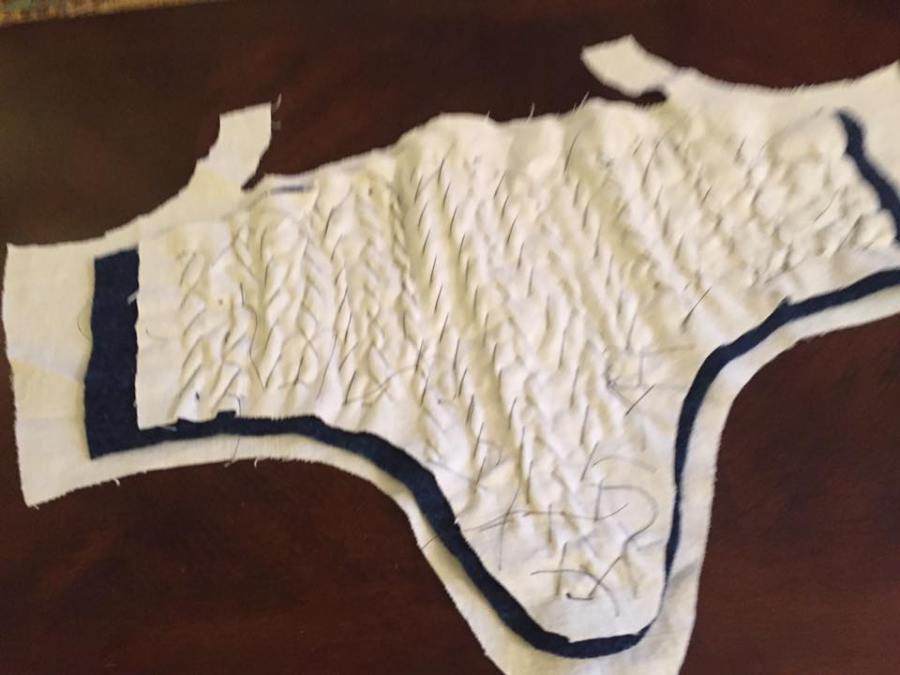
The front of each piece of the doublet was flat lined with a pad stitched wool-and-canvas layer. Each back piece was also flat lined with an additional wool-and-canvas layer. At this step, it became necessary to adapt the layout of the pad stitching on a doublet back, since the pattern for this was rotated. Unfortunately, in my haste, I failed to take any photos of this stage. However, I include here a photo of the pad stitching in the kyrtle, which uses the same wool and canvas structure, and a photo that shows the layout of the pad stitching in the top of the back of the monghil.
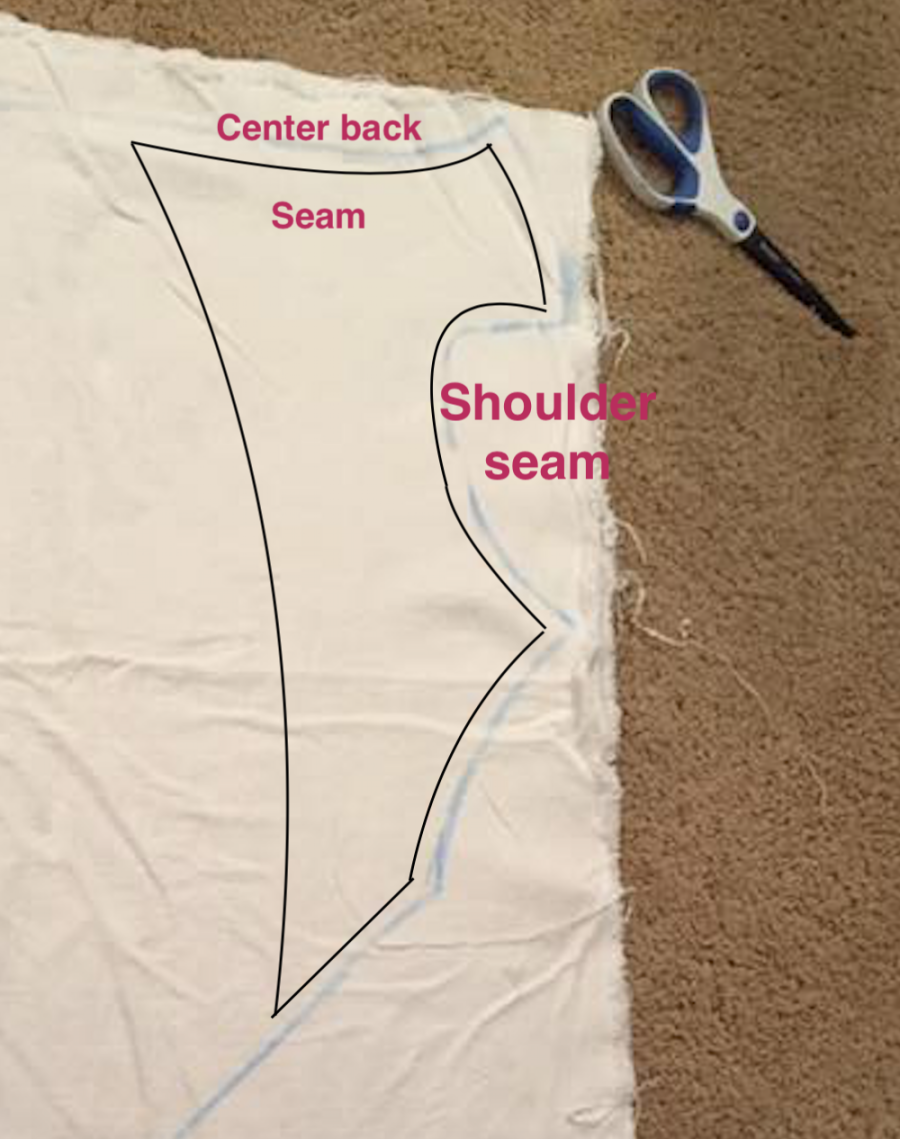
The monghil in back has one layer of heavy, machine-fulled wool and one layer of internal canvasing, in addition to the fashion fabric and the linen canvas lining. In front, the doublet and skirt are fully canvased AND lined in medium to lightweight purple linen that is the same color as the dress.
One the flat lining for each of the pieces was completed, I sewed the front skirt panels (cut per the de Alcega pattern) to the fronts of the doublet, and added the two collar pieces to the front of the doublet. Then, I sewed the two back pieces together at the center back.
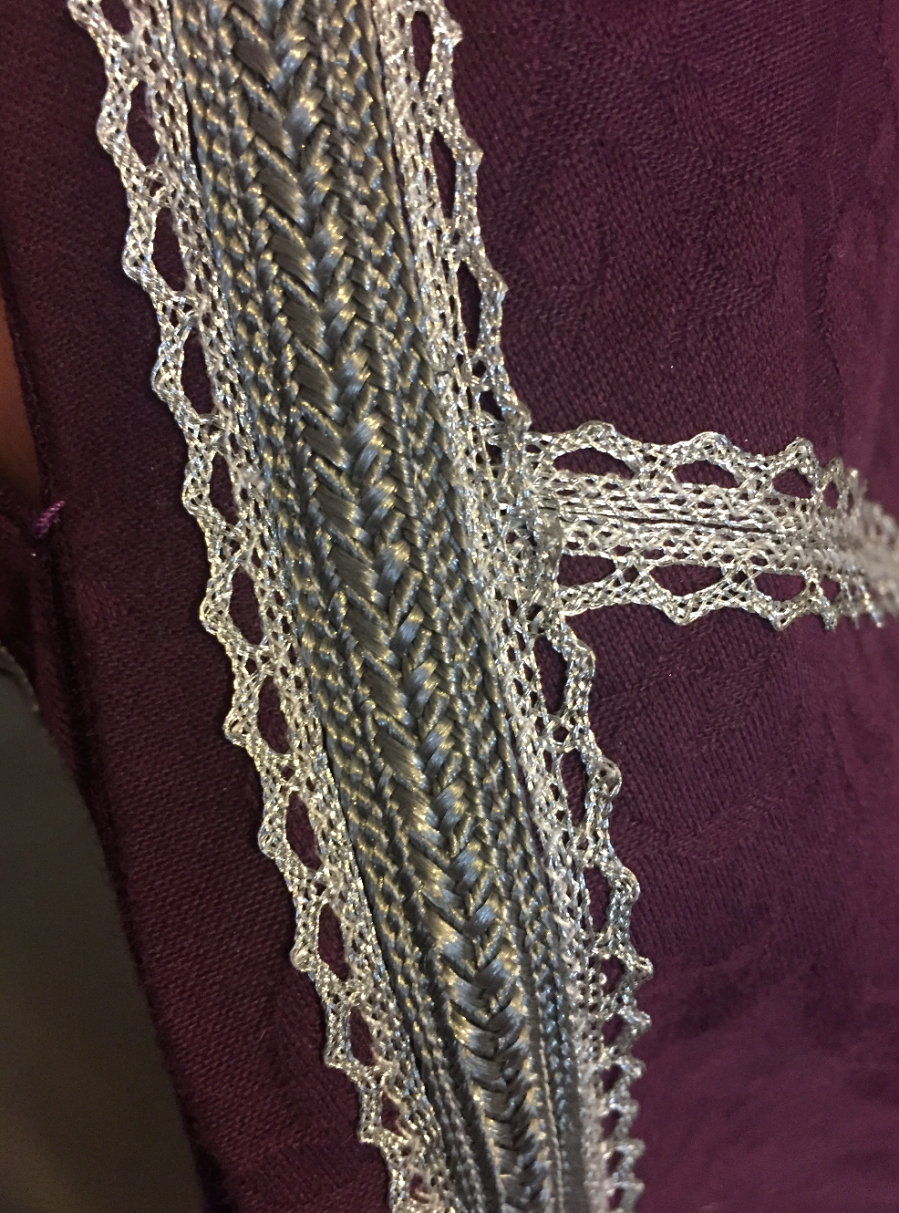
At this point, I sewed the back to the front at the shoulder seam only, and applied all the trim. This step took bloody forever. The trim is not one wide band. Rather, it’s three strips: a center one that much be sewn twice, and two lace strips that each must be sewn once. I left the sides open so I could access the trim up and over the shoulder and collar more easily. I left the trim unsewn on the sides of the skirt for a foot or so on either side of the seam; then, lining it all up carefully, I completed the seams at that point. You can see where the skirt join hides the ends of the trim.
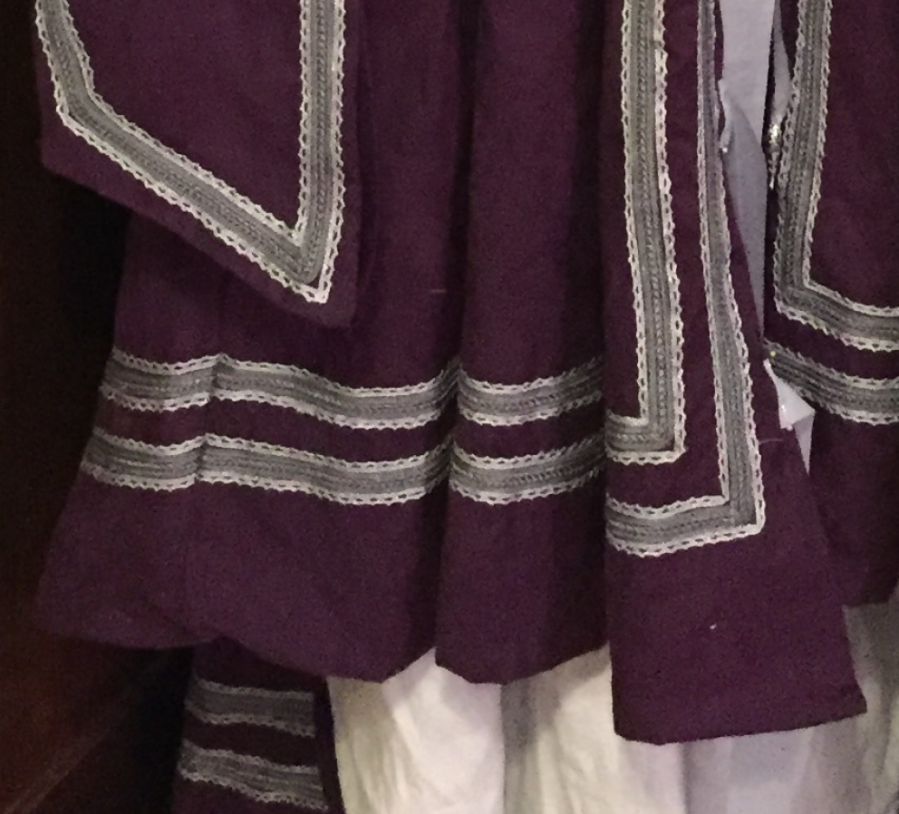
The next step was inserting the lining (purple in front, and white in back, since I didn’t have enough of the purple linen). The lining side seams have the false back. Rather than making a full back or having laces all the way around (more mess to deal with in dressing), I inserted 3” wide by 7” tall extra wide lacing strips made of two layers of linen canvas, using metal grommets for ease (frankly, since the trim took so very long I was running out of time.
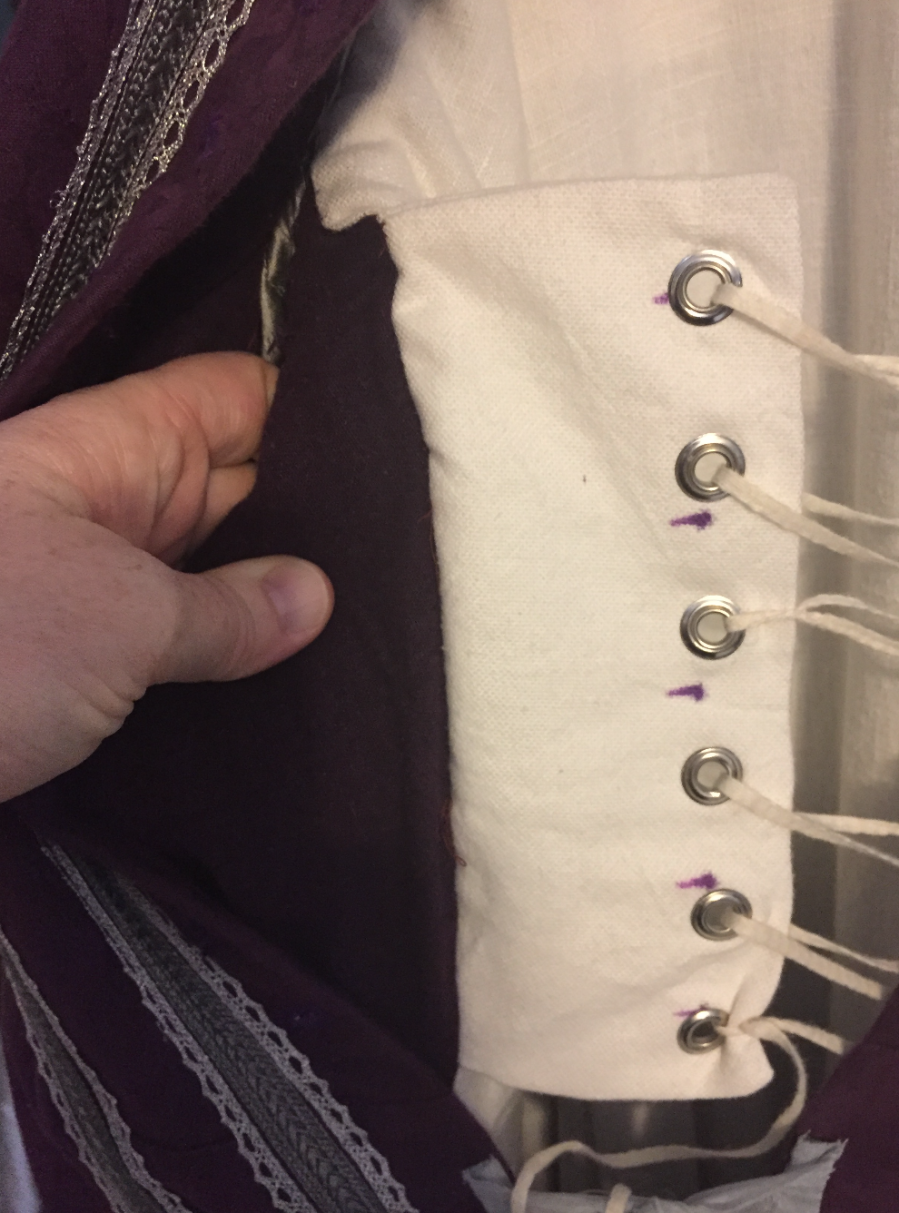
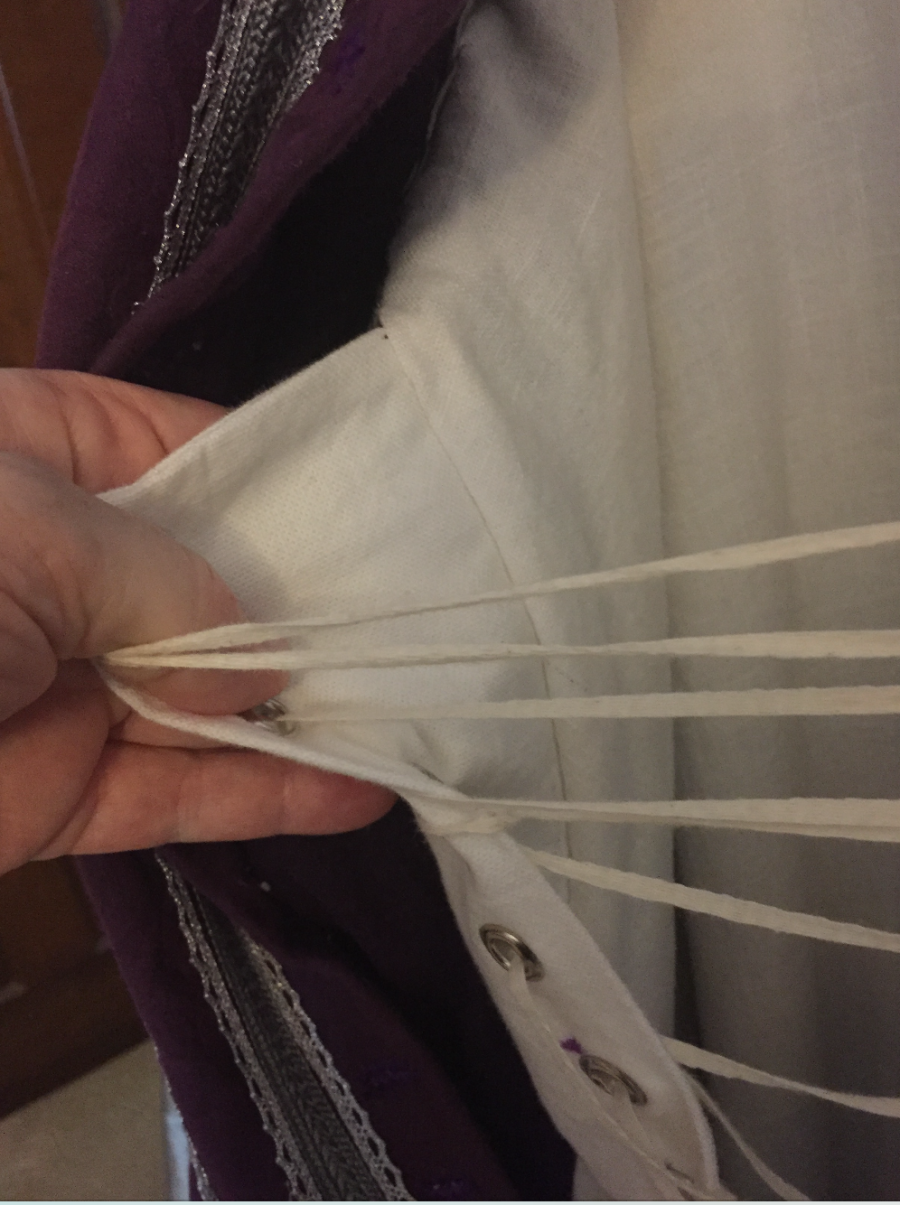
Sleeves
Then it was time to cut the sleeves. I love a tank top but not in Spanish court clothing! This is …. a look.
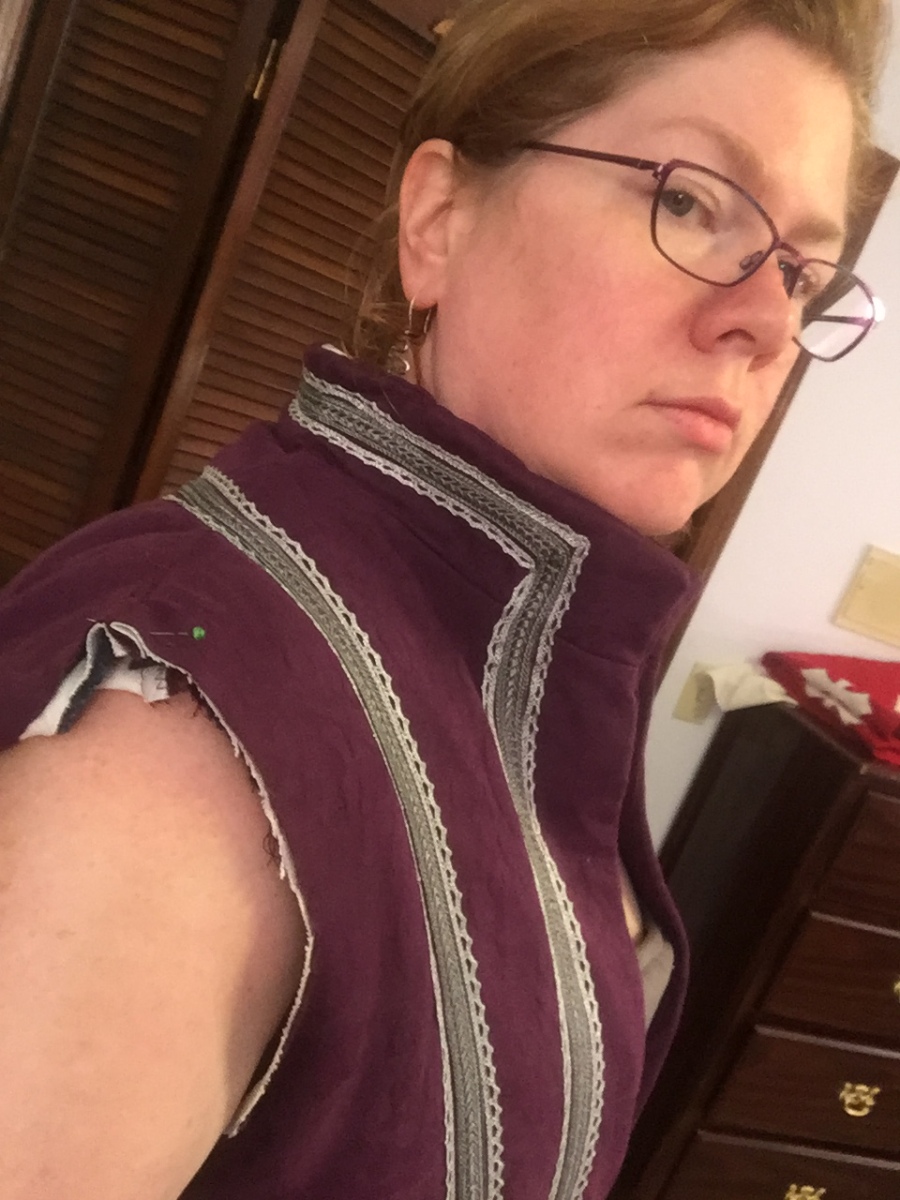
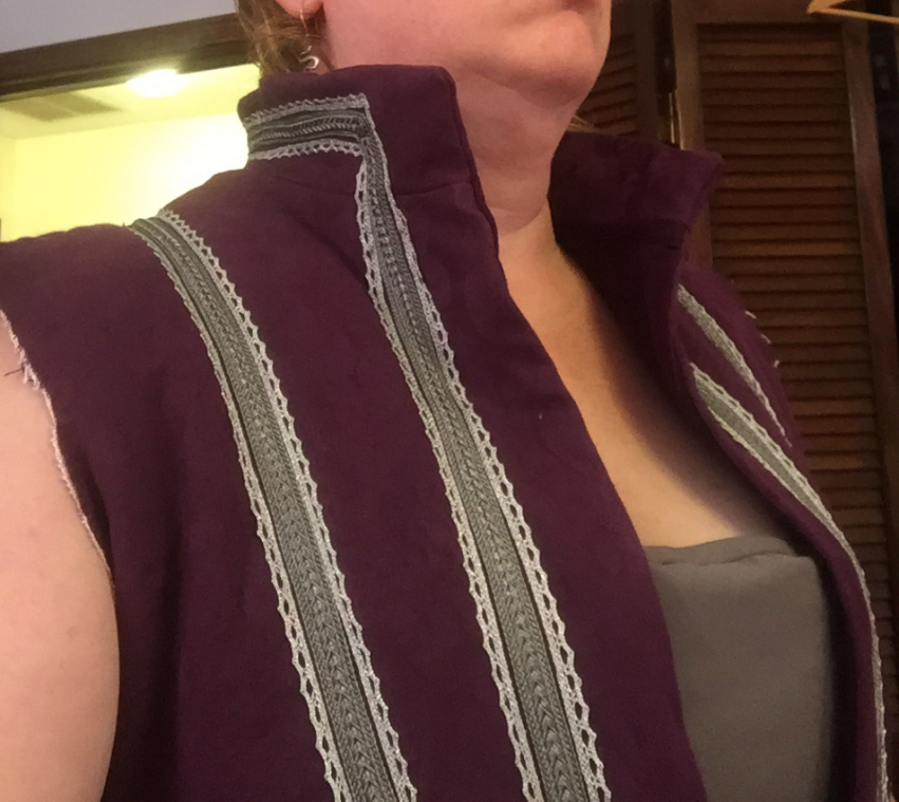
Using the pattern in Arnold’s first Patterns of Fashion, I scaled the size up to my armscye size, bearing in mind that the sleeves are gathered in on the orginal. Now, the Pfalzgrafin Dorothea Sabina’s dress, which I have seen in the National Museum of Bavaria in Munich, was made for a much shorter lady, so I did lengthen them a bit as well so that the proportions were maintained. The sleeves are two part sleeves, and each had the trim applied before they were lined – again, in the purple linen. They were completed in four individual parts and then sewn into the armscyes. The undersleeves, which are whip-stitched into the overdress, are likewise completed as two sleeves with a bound edge at the wrist before they were whip stitched in. If I had more time, I probably would have laced these sleeves into the dress with points and lacing rings.
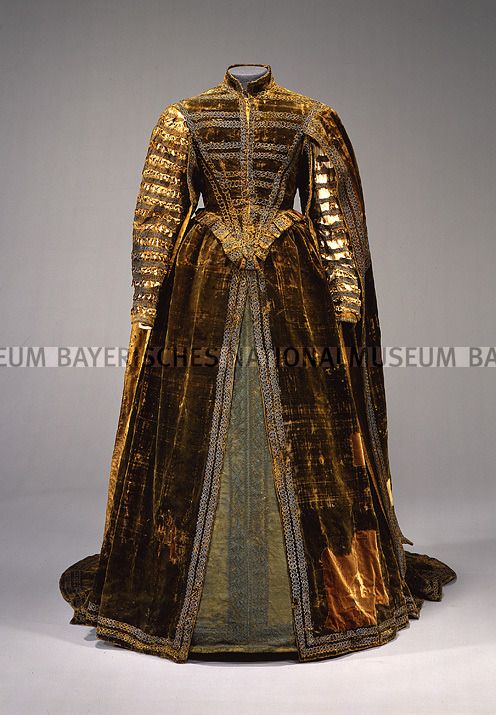
Photo courtesy of the Bavarian National Museum.
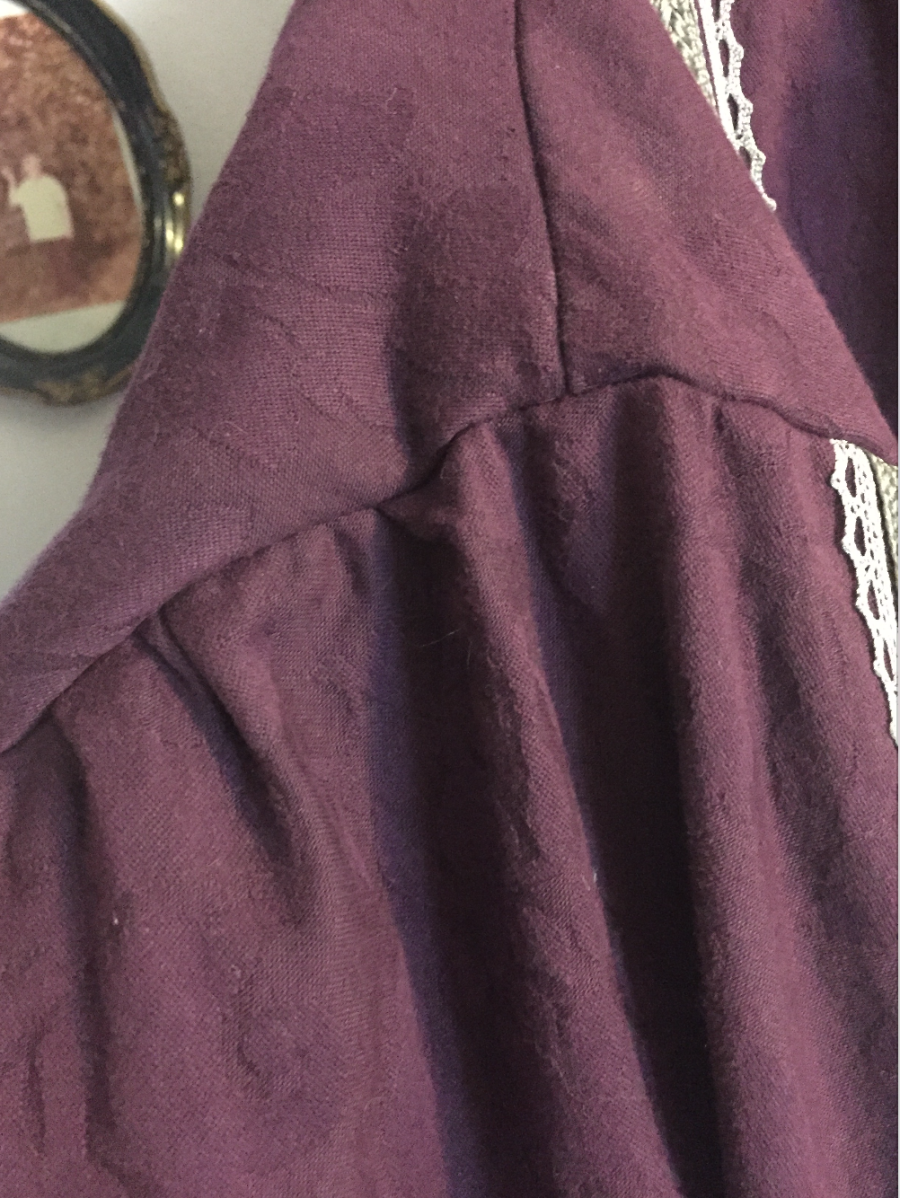
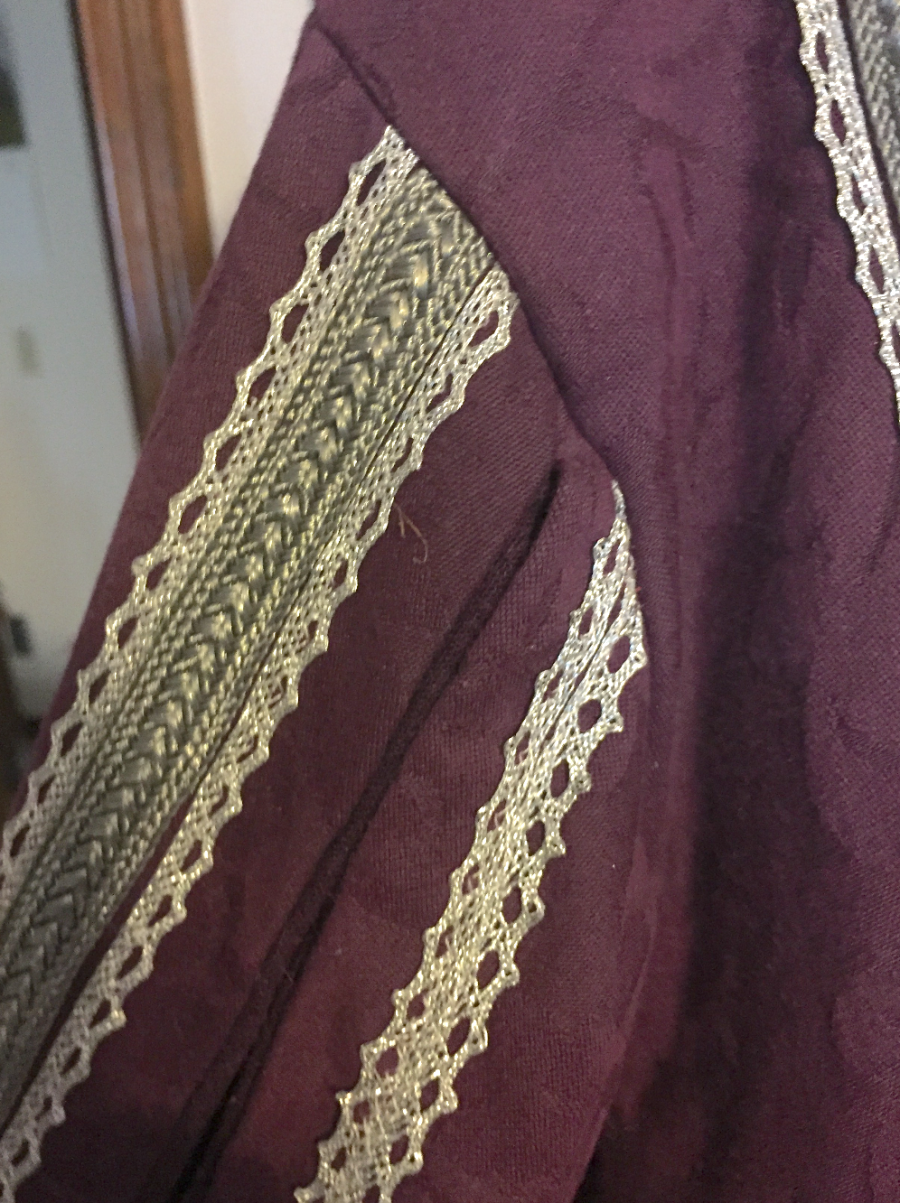
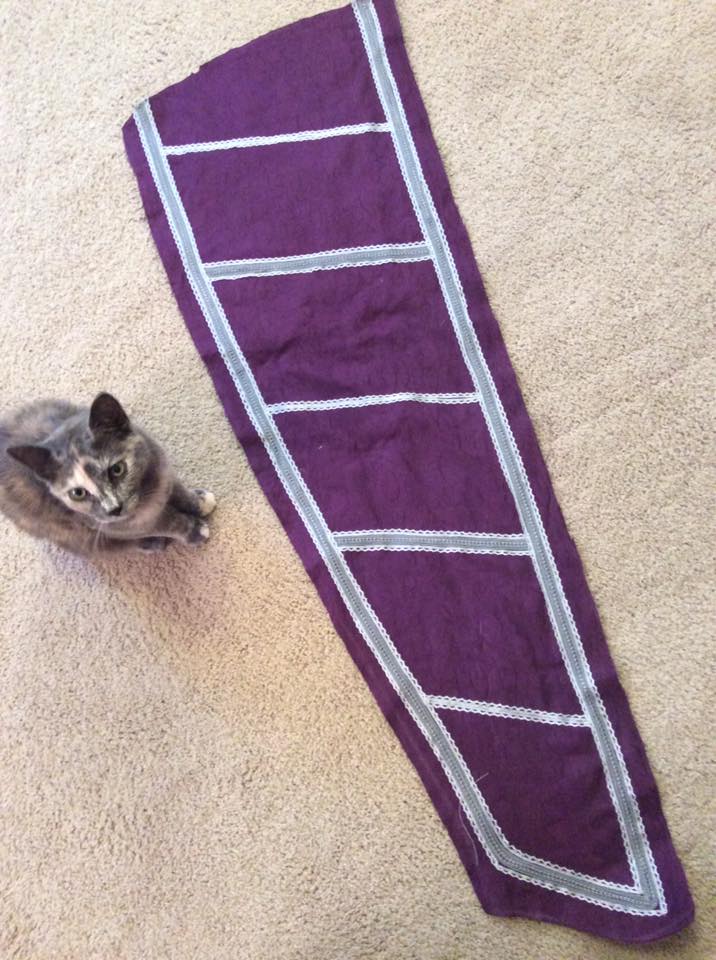
Finishing
Then, I hemmed this monster.
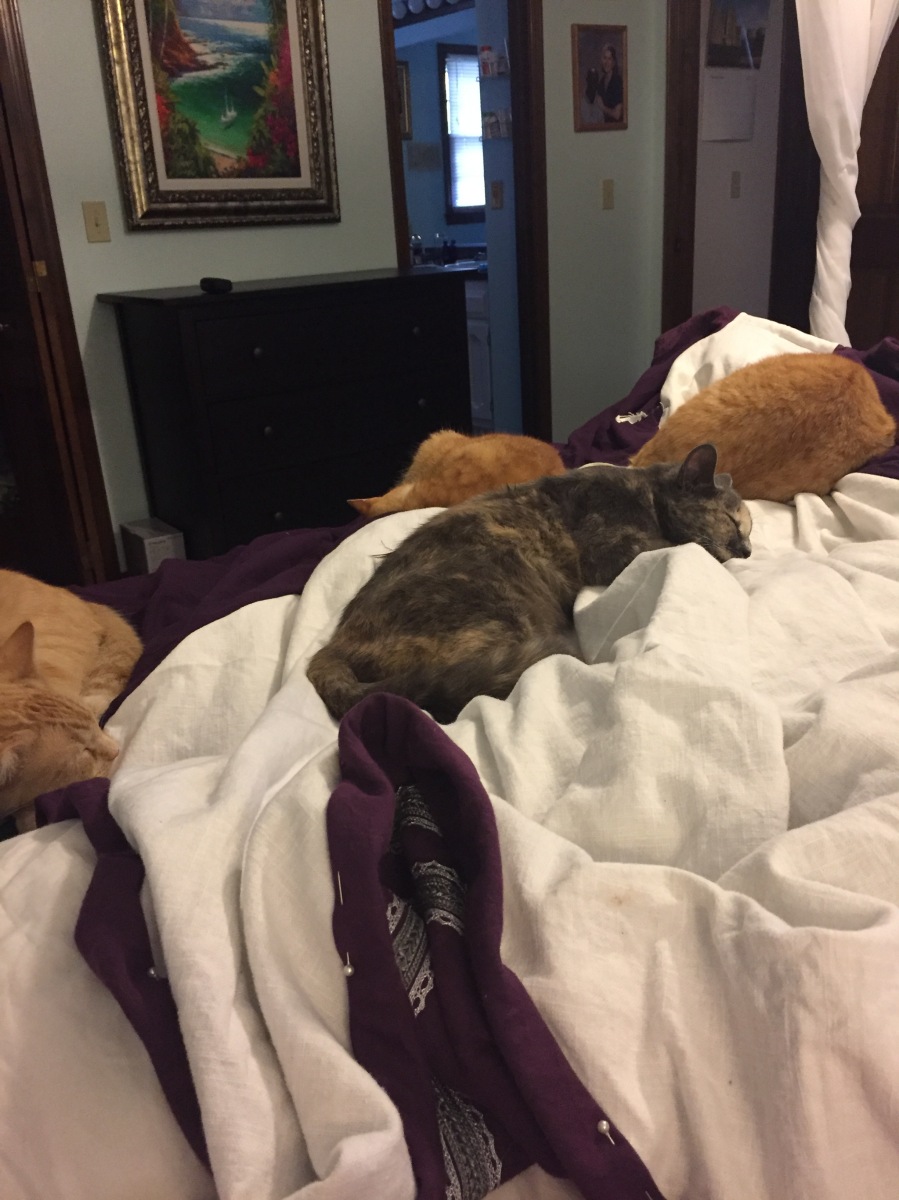
L-R: Loki, Phryne, Jack, and Thor.
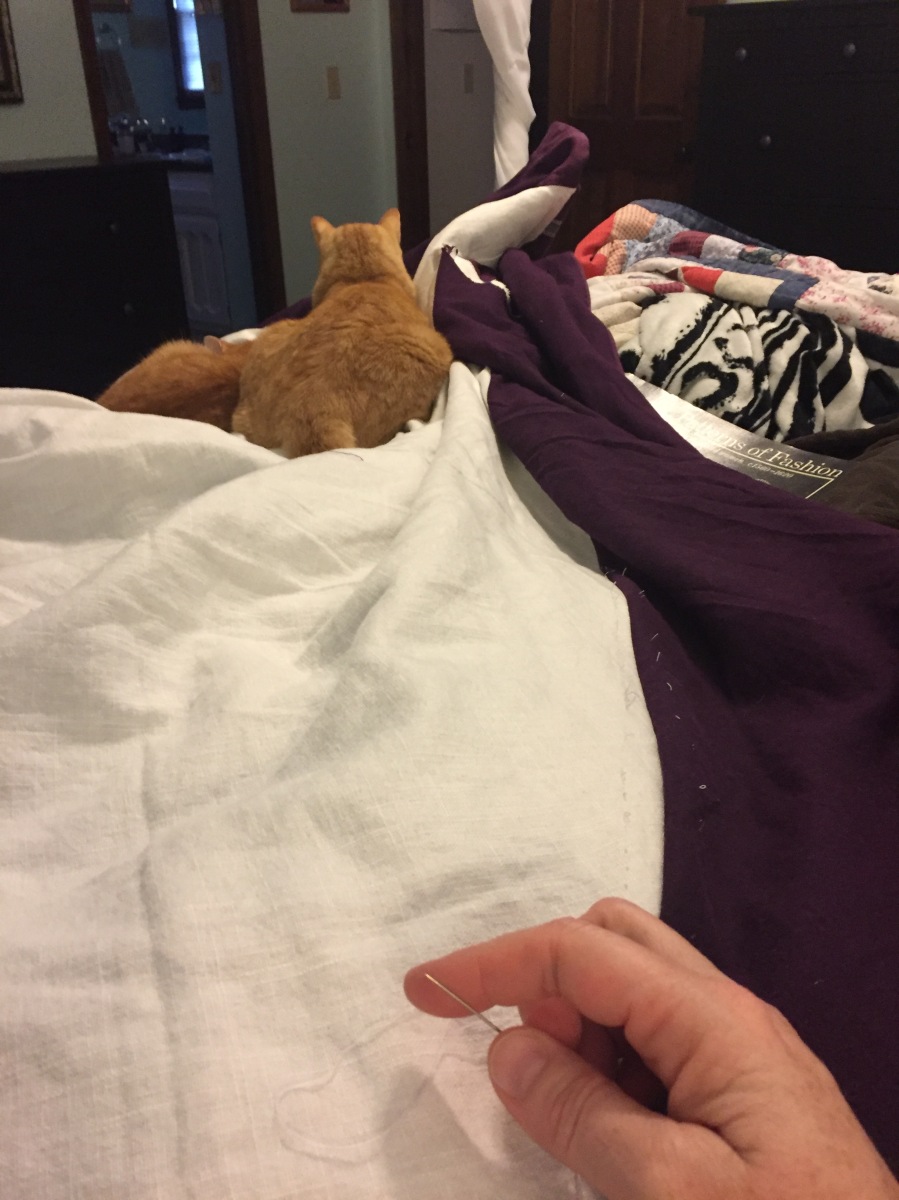
Y’all, this took AGES, and it was so heavy that I had to spread it across my bed to be able to hem it efficiently. Several small assistants volunteered to be helpy. They were VERY HELPY. (Note POF is on the bed with me – I was actually still thinking about the sleeve trim while I was hemming. I’d hem a bit, then work on the sleeves, then hem a bit. My fingers were crooked by the time I was done!)
The dress was hemmed, the sleeves were on (and tacked shut at strategic points, like Dorothea’s sleeves). The trim was completed.
And now, it was time to consider closures. I have all the buttons, because I run a business called Two Baronesses with my best friend, Baroness Leda. (My online button shop is at www.badbaronessbuttons.com)
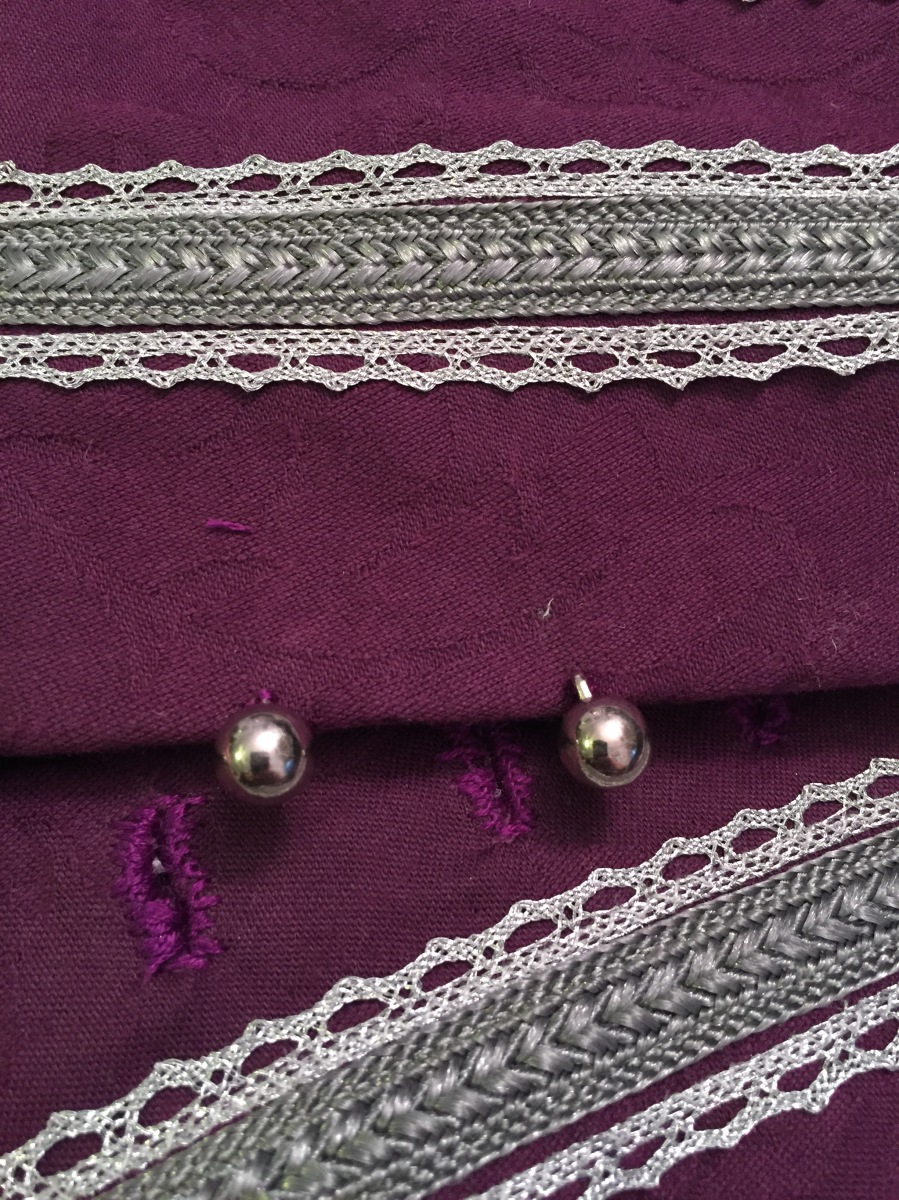
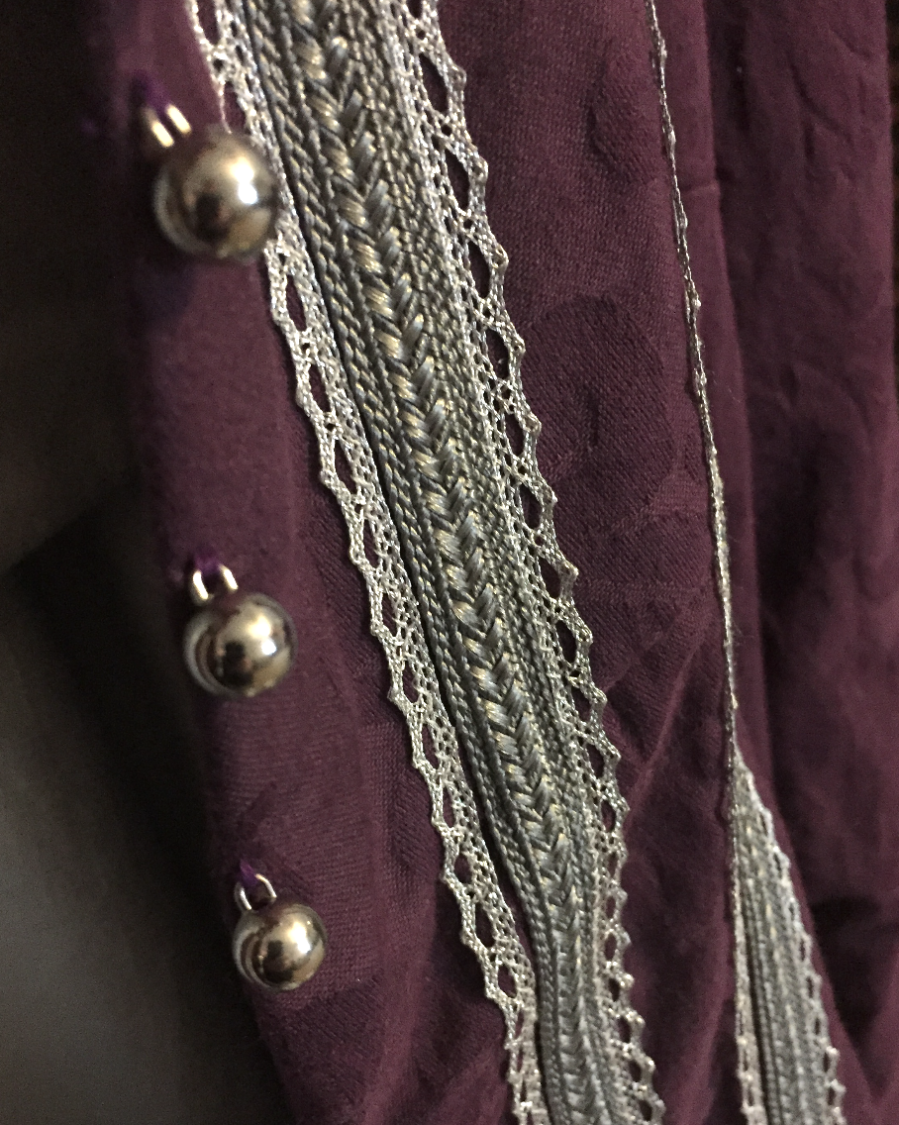
I prefer a relatively simple aesthetic and this dress was already VERY SHINY. I won’t even mention that I didn’t think it was my place to stand out, only fit in to the group. Therefore, I decided on a plain, round ball button, which I have made to my specifications. It’s a bright silver, it’s solid metal, and it is a shank button. Then, I made hand stitched button holes. My button holes are not as neat as they could be, mostly because my hands hurt so badly by this point, but considering I had 5 days until the event and I was coordinating the Vigil and elevation, I only needed them to be acceptable and functional.
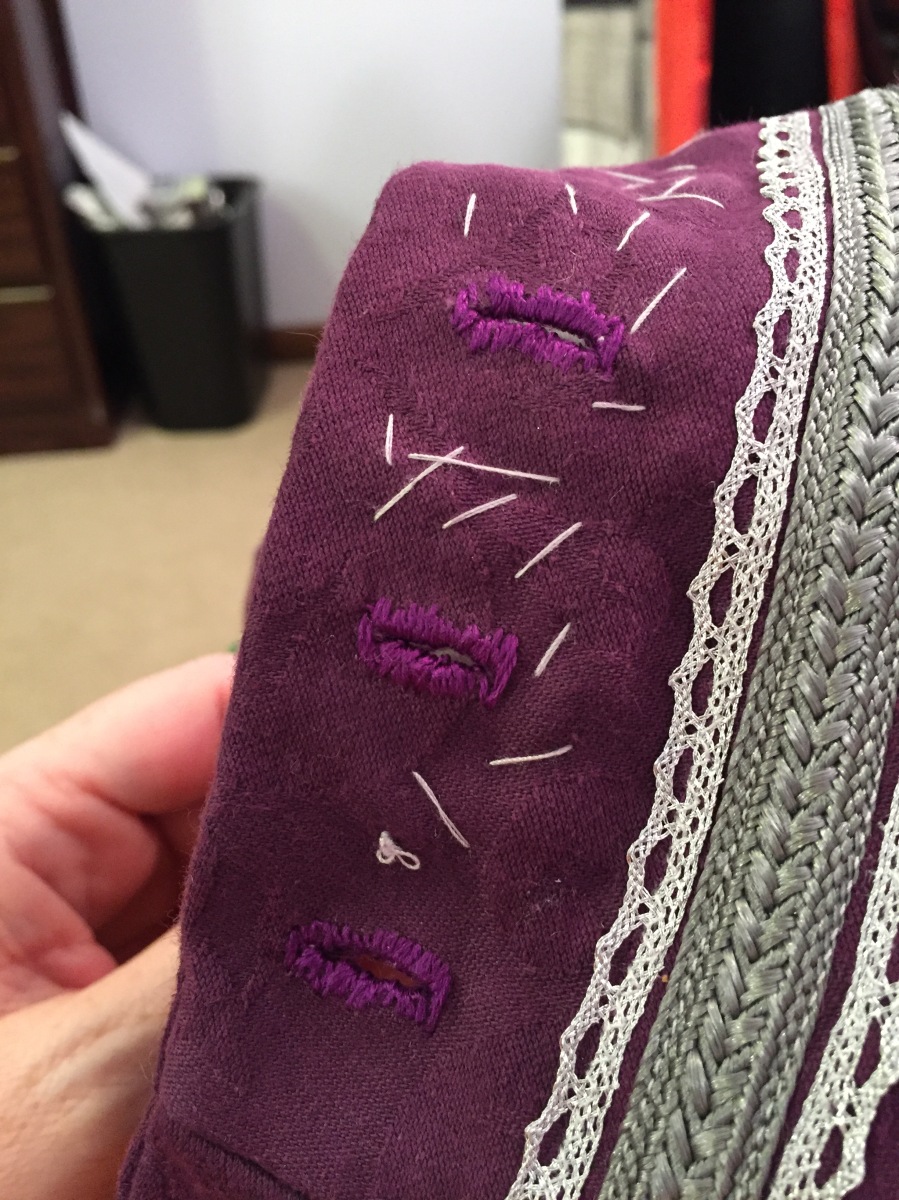
Finally, the skirt is closed with wide silk chiffon ties in grey. I also sell these points, and I think these closures (widely seen on Spanish court clothing of this period), really finish off the look.

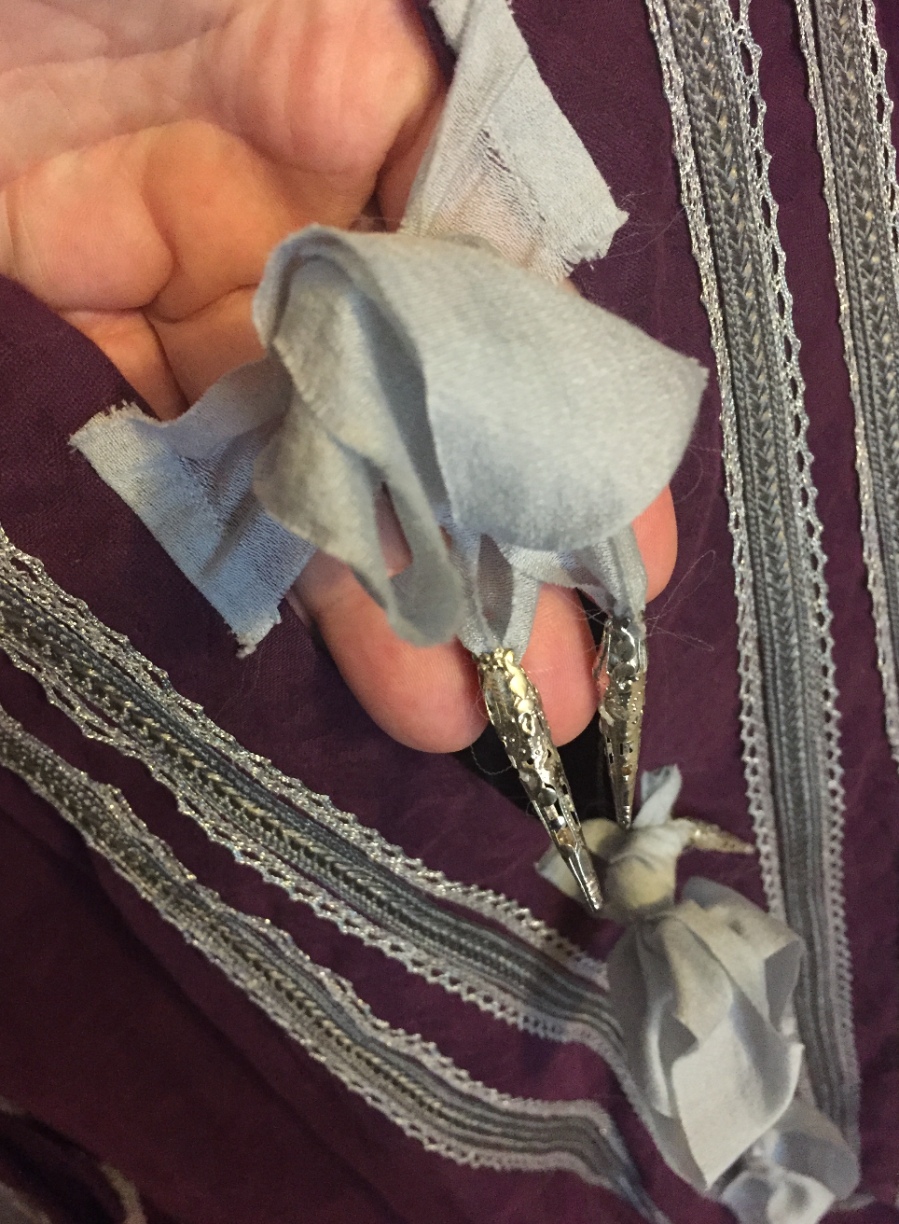
Conclusion
And here’s how it fits! Pardon the cameo from Loki Snakebringer. He is generally my buddy and he always wants a cuddle at the most inopportune moments. However, you can tell from the photos that the dress is very easy to move in, and I am pleased with the fit. I really love the sleeves, so my lack of fabric really worked out to my advantage in the end.

PHOTO BY SHERYL ANNE
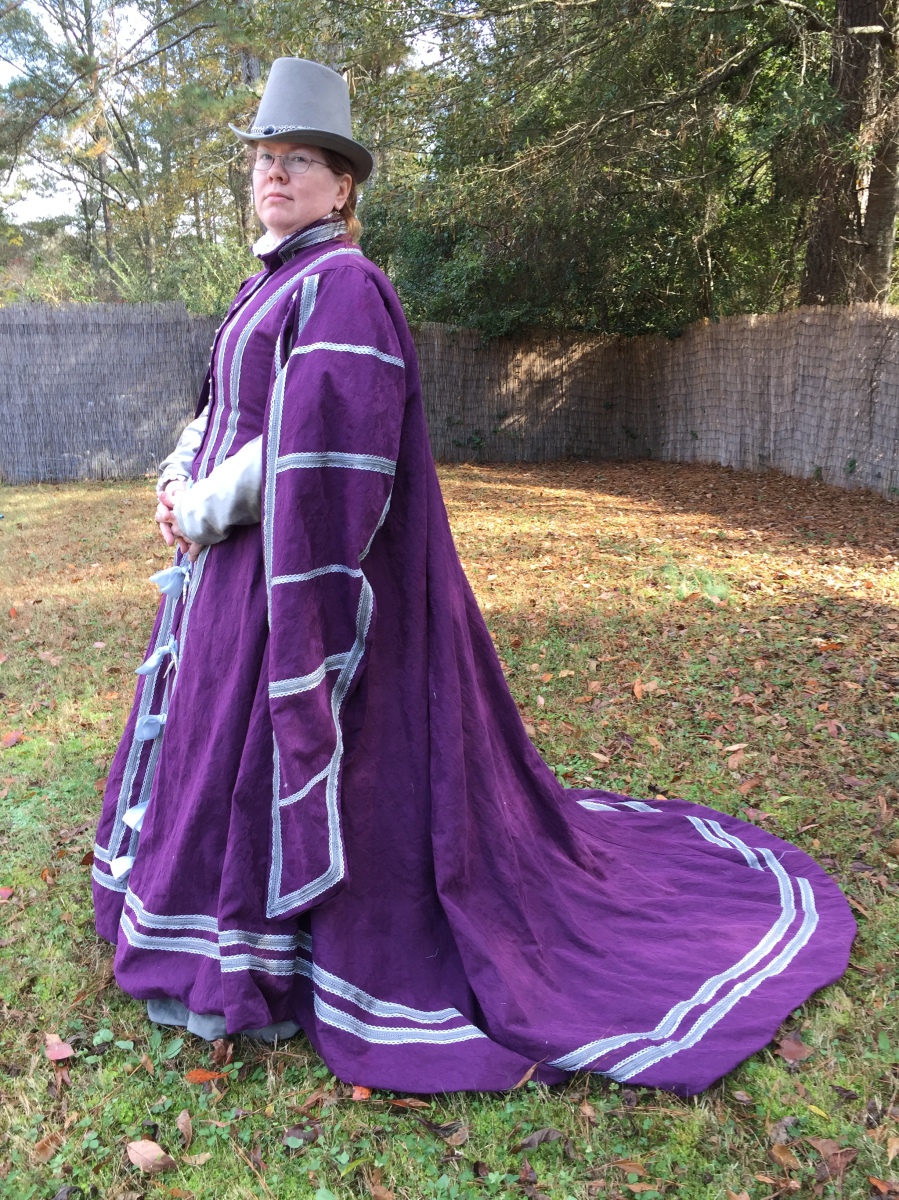
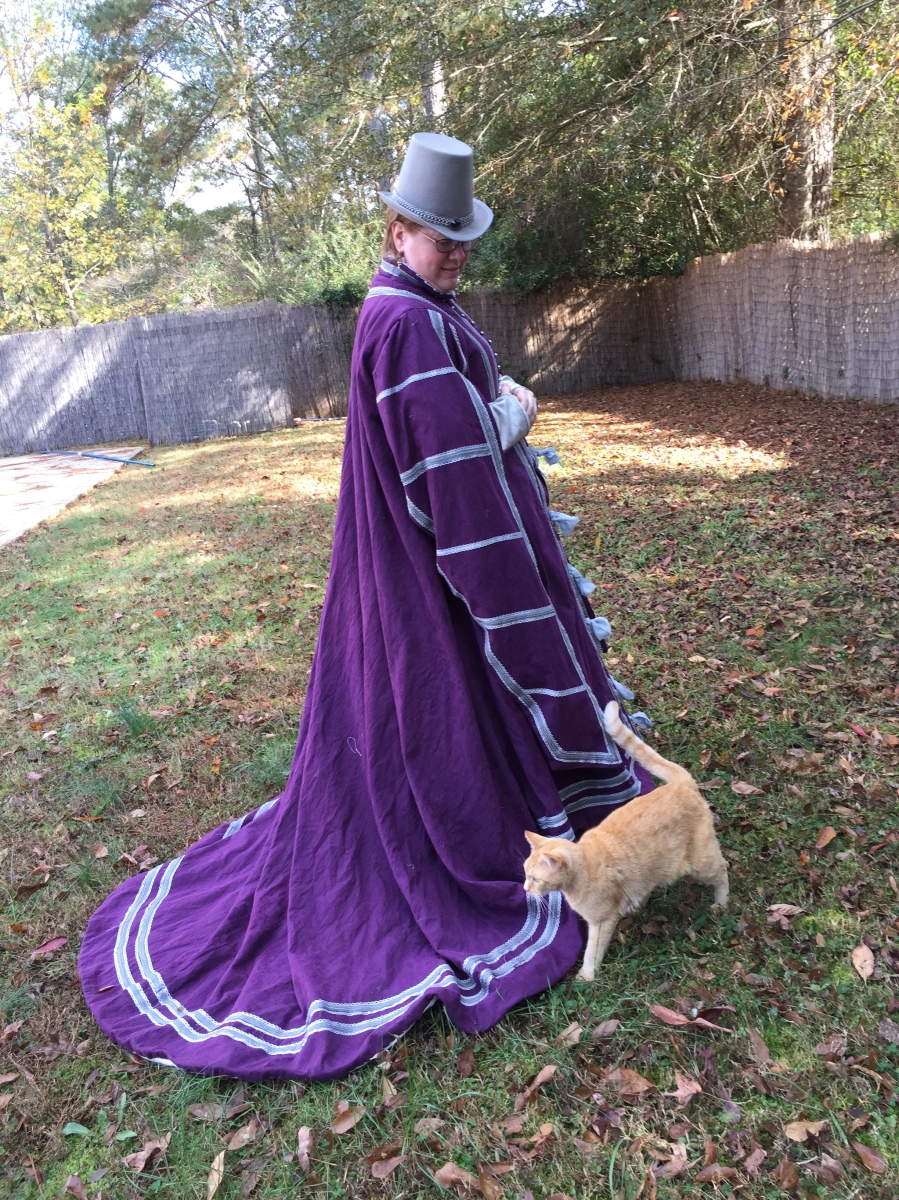
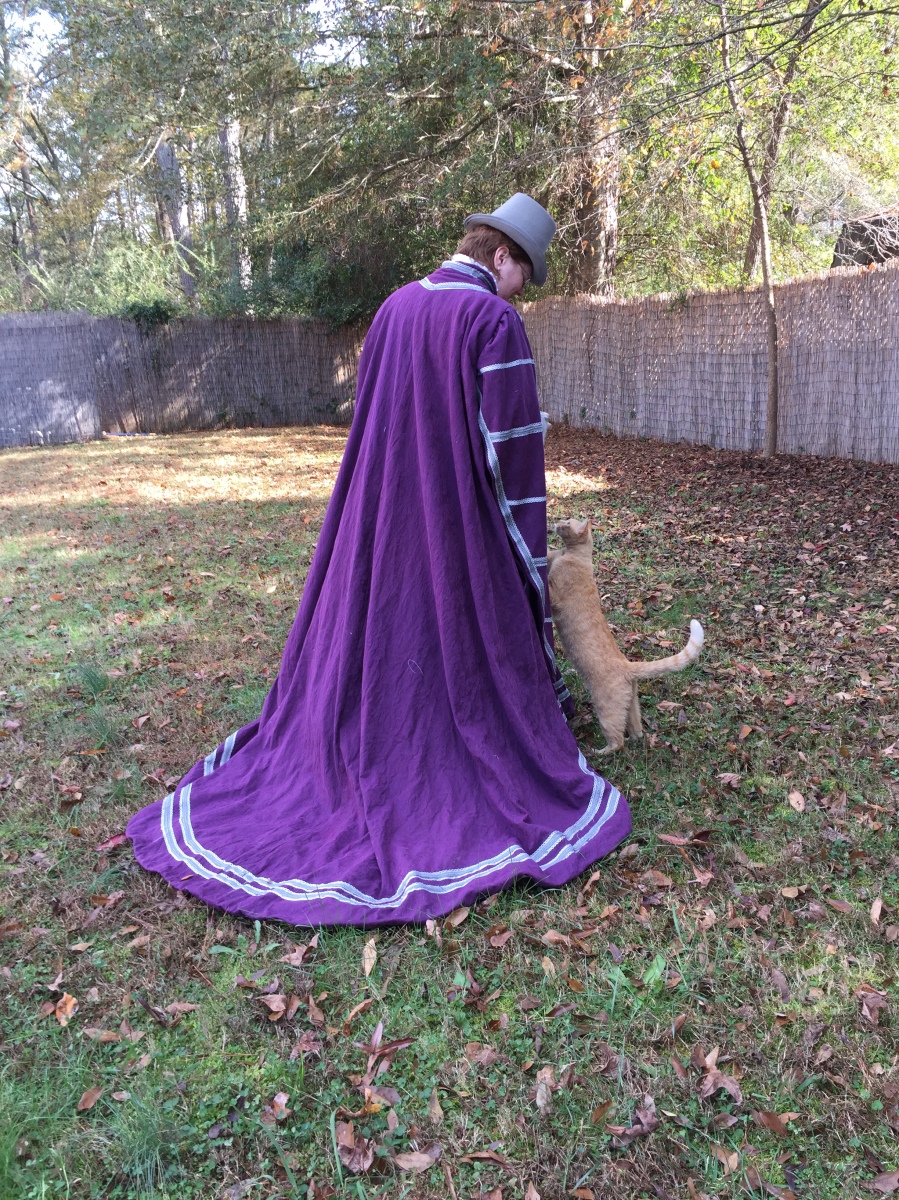
I really love the way the fullness is distributed across the back of this garment.
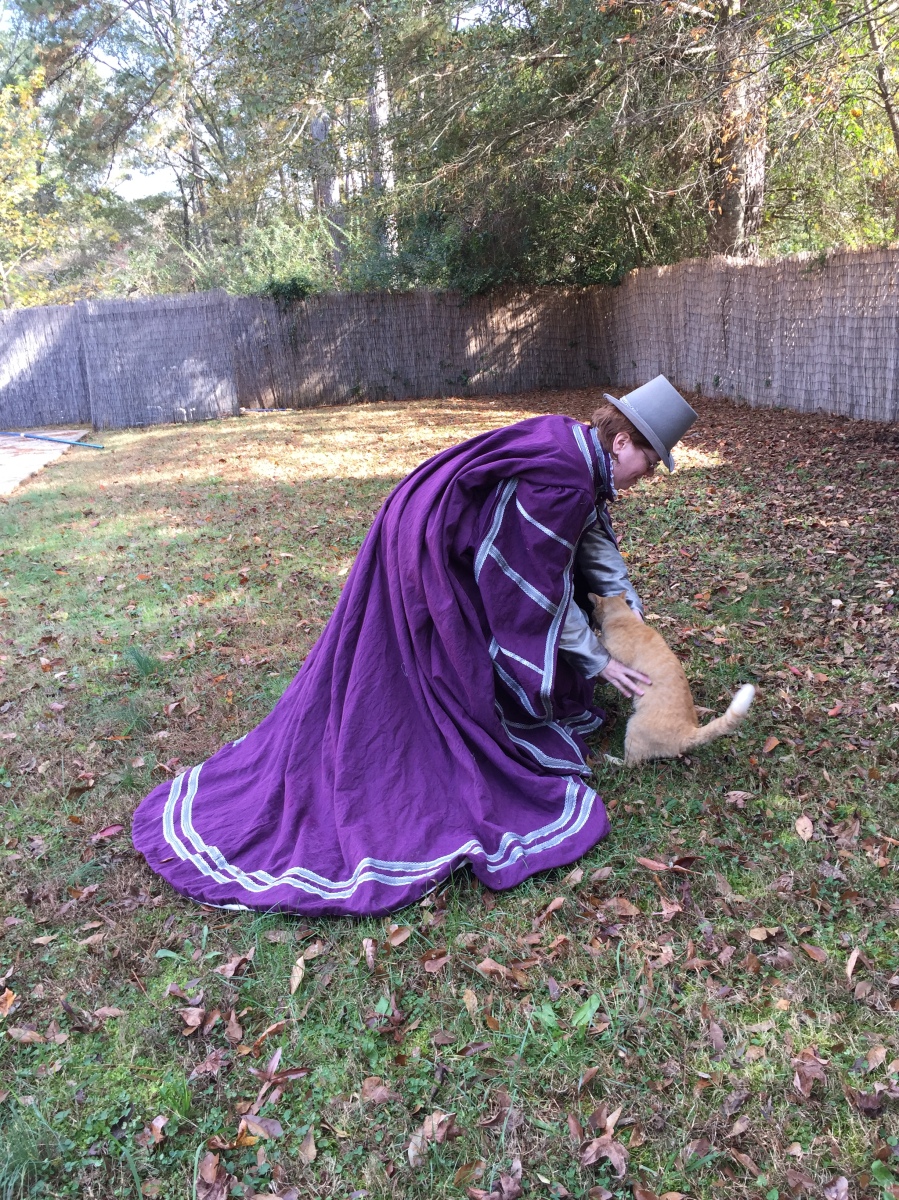
If you can’t pick up a 15 pound cat in your court dress why even bother?
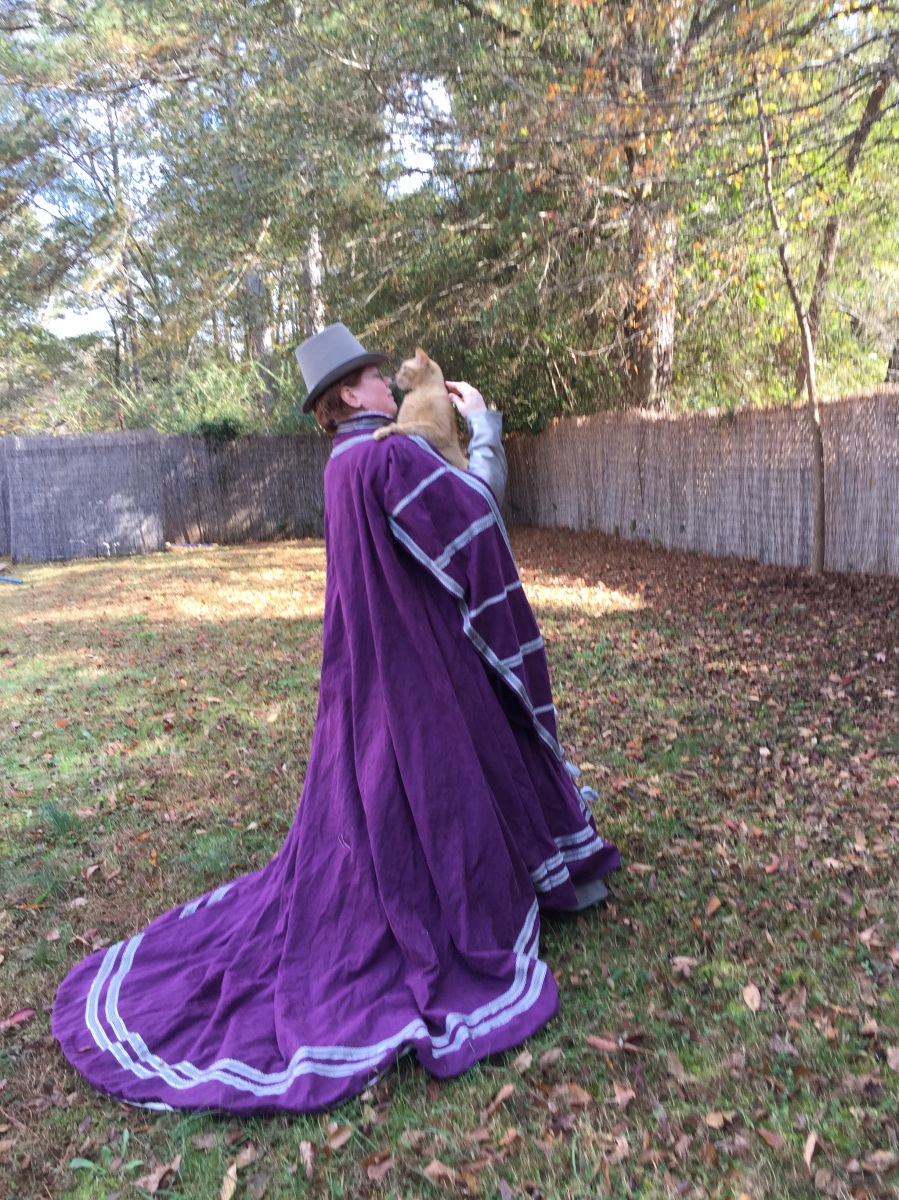
Bibliography
Bayerisches Nationalmuseum (Bavarian National Museum)- München, Bayern Germany. Gewand der Pfalzgräfin Dorothea Sabina(Garment of Countess Dorothea Sabina) 1598. Inv.-Nr. T 4382 – T 4403. http://www.bayerisches-nationalmuseum.de/index.php?id=508&tx_paintingdb_pi%5Bp%5D=10&cHash=2cd9b2365c68efc48b5179b4f217ed8c (Accessed July 13, 2018.)
de Alcega, Juan. 1589. Libro de Geometria y Traça. Madrid. (facsimile available from Costume and Fashion Press).
de Anduxar, Martin. 1640. Geometria y Traza Pertenecientes al Oficio de Sastres. Madrid.
Arnold, Janet. 1985. Patterns of Fashion (1): The Cut and Construction of Clothes for Men and Women, 1560-1620. London: Quite Specific Media (Macmillan).
de Freyle, Diego. 1588. Geometria y Traça para el Oficio de los Sastres. Seville.
de la Rocha Burguen, Francisco. 1618. Geometria y Traça Perteneciente al Oficio de los Sastres. Valencia.
Gnagy, Mathew. 2018. “Monghil Trançado” Elizabethan Costuming. Last accessed July 20, 2018. http://www.elizabethancostume.net/blog/alcega-mongil-trancado-16th-c-sack-backed-gown/
Gnagy, Mathew. 2014. Modern Maker Volume 1.New York: Mathew Gnagy. Available online at Amazon and at ModernMaker.net
Gnagy, Mathew. 2018. Modern Maker Volume 2: Pattern Manual 1580-1640.New York: Mathew Gnagy. Available online at Amazon and at ModernMaker.net
